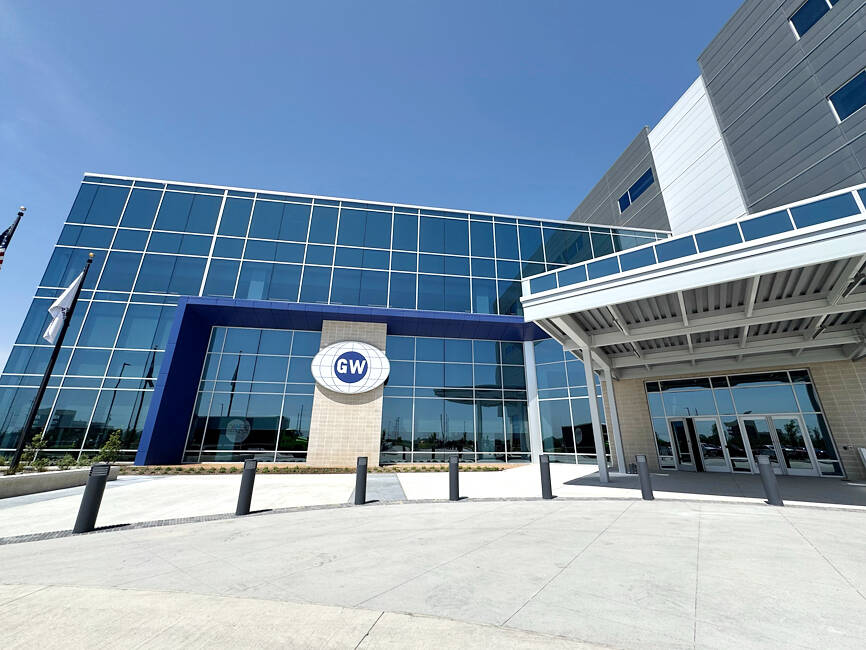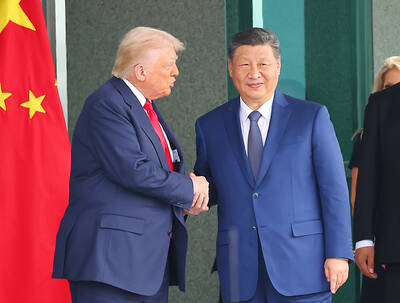GlobalWafers Co (環球晶圓), the world’s third-largest silicon wafer supplier, yesterday said that customers’ inventory corrections are nearing completion, and it expects full-year revenue to exceed last year’s level, excluding the effects of foreign exchange rate fluctuations.
The company expects modest revenue growth next year, supported by a continued recovery in the semiconductor industry, driven by demand for artificial intelligence (AI) and high-performance computing (HPC) applications.
“We believe that the most challenging phase is behind us,” GlobalWafers chairwoman Doris Hsu (徐秀蘭) told an online investors’ conference.

Photo courtesy of GlobalWafers Co
“The pace of recovery remains uneven across applications... AI and data center demand continues to drive investment in advanced nodes, while the PC and mobile segments remain muted, and we are gradually beginning to see positive signals from the automotive and industrial sectors,” Hsu said.
GlobalWafers’ revenue in the first half of this year expanded 3.9 percent annually to NT$31.6 billion (US$1.06 billion) — the third-highest first-half performance in the company’s history.
Although supply chain inventories are gradually declining, customer procurement decisions are increasingly influenced by geopolitical tensions and tariff-related considerations, prompting a shift toward regional sourcing strategies, the company said.
A potential challenge looms if Taiwanese semiconductor companies are subjected to a 20 percent tariff following the conclusion of a US Section 232 investigation under the Trade Expansion Act of 1962, as the company’s rivals are to be levied at a lower rate of 15 percent, Hsu said.
However, GlobalWafers said its global manufacturing footprint and cross-site product qualifications with customers provide the flexibility to shift production and shipments to regions with optimized cost structures.
The company is accelerating qualification processes and ramping up production at overseas sites to ensure resilient local supply, Hsu said.
If strong demand in the US persists, the company would consider advancing the next phase of capacity expansion to further enhance local support, she added.
GlobalWafers also operates production facilities in Taiwan, Japan, South Korea and Europe.
The company reported second-quarter net profit of NT$1.68 billion, up 15 percent from NT$1.46 billion in the previous quarter. However, net profit declined 41 percent from NT$2.88 billion a year earlier.
Earnings per share rose to NT$3.52 last quarter, up from NT$3.05 in the previous quarter, but down from NT$6.02 a year earlier.
Gross margin declined to 25.8 percent, compared with 26.4 percent in the first quarter and 32.3 percent in the same period last year, attributable to higher depreciation expenses and increased costs associated with the company’s global capacity expansion plans.
Factory utilization improved on a quarterly basis, with the loading rate of 12-inch silicon wafer production lines rising to more than 90 percent, and 8-inch lines operating at about 80 percent. Equipment usage for small-diameter wafers, such as 6-inch wafers, reached 70 percent, the company said.

Nissan Motor Co has agreed to sell its global headquarters in Yokohama for ¥97 billion (US$630 million) to a group sponsored by Taiwanese autoparts maker Minth Group (敏實集團), as the struggling automaker seeks to shore up its financial position. The acquisition is led by a special purchase company managed by KJR Management Ltd, a Japanese real-estate unit of private equity giant KKR & Co, people familiar with the matter said. KJR said it would act as asset manager together with Mizuho Real Estate Management Co. Nissan is undergoing a broad cost-cutting campaign by eliminating jobs and shuttering plants as it grapples

TEMPORARY TRUCE: China has made concessions to ease rare earth trade controls, among others, while Washington holds fire on a 100% tariff on all Chinese goods China is effectively suspending implementation of additional export controls on rare earth metals and terminating investigations targeting US companies in the semiconductor supply chain, the White House announced. The White House on Saturday issued a fact sheet outlining some details of the trade pact agreed to earlier in the week by US President Donald Trump and Chinese President Xi Jinping (習近平) that aimed to ease tensions between the world’s two largest economies. Under the deal, China is to issue general licenses valid for exports of rare earths, gallium, germanium, antimony and graphite “for the benefit of US end users and their suppliers

Dutch chipmaker Nexperia BV’s China unit yesterday said that it had established sufficient inventories of finished goods and works-in-progress, and that its supply chain remained secure and stable after its parent halted wafer supplies. The Dutch company suspended supplies of wafers to its Chinese assembly plant a week ago, calling it “a direct consequence of the local management’s recent failure to comply with the agreed contractual payment terms,” Reuters reported on Friday last week. Its China unit called Nexperia’s suspension “unilateral” and “extremely irresponsible,” adding that the Dutch parent’s claim about contractual payment was “misleading and highly deceptive,” according to a statement

The Chinese government has issued guidance requiring new data center projects that have received any state funds to only use domestically made artificial intelligence (AI) chips, two sources familiar with the matter told Reuters. In recent weeks, Chinese regulatory authorities have ordered such data centers that are less than 30 percent complete to remove all installed foreign chips, or cancel plans to purchase them, while projects in a more advanced stage would be decided on a case-by-case basis, the sources said. The move could represent one of China’s most aggressive steps yet to eliminate foreign technology from its critical infrastructure amid a